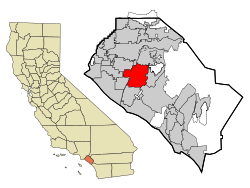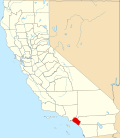Santa Ana, California | |
|---|---|
Top: Santora Building (left) and Santa Ana Regional Transportation Center (right); middle: Santa Ana City Hall (left), West Coast Theatre (center), and high rises (right); bottom: Bowers Museum (left) and Old Santa Ana Courthouse | |
| Motto: Education First | |
 Location of Santa Ana within Orange County, California | |
Location in the Los Angeles Metropolitan Area Location in California | |
| Coordinates: 33°44′27″N117°52′53″W / 33.74083°N 117.88139°W | |
| Country | United States |
| State | California |
| County | Orange |
| Founded | 1869 [1] |
| Incorporated | June 1, 1886 [2] |
| Named after | Saint Anne |
| Government | |
| • Mayor | Valerie Amezcua [3] |
| • Mayor pro tem | Benjamin Vazquez |
| • City council | Thai Viet Phan Jessie Lopez Phil Bacerra Johnathan Ryan Hernandez David Penaloza |
| • City manager | Alvaro Nuñez |
| Area | |
• Total | 27.37 sq mi (70.89 km2) |
| • Land | 27.34 sq mi (70.81 km2) |
| • Water | 0.031 sq mi (0.08 km2) 0.90% |
| Elevation | 115 ft (35 m) |
| Population | |
• Total | 310,227 |
| • Rank | (2023) 3rd in Orange County 14th in California 65th in the United States |
| • Density | 11,350/sq mi (4,381/km2) |
| Demonyms |
|
| Time zone | UTC−8 (Pacific) |
| • Summer (DST) | UTC−7 (PDT) |
| ZIP Codes [7] | 92701–92708, 92711, 92712, 92728, 92735, 92799 |
| Area code | 657/714, 949 |
| FIPS code | 06-69000 |
| GNIS feature IDs | 1652790, [5] 2411814 |
| Website | santa-ana.org |
Santa Ana (Spanish for ' Saint Anne ') is a city in and the county seat of Orange County, California, United States. Located in the Greater Los Angeles region of Southern California, the city's population was 310,227 at the 2020 census. As of 2023, Santa Ana is the third most populous city in Orange County (after Anaheim and Irvine), the 14th-most populous city in California, and the 65th most populous city in the United States. Santa Ana is a major regional economic and cultural hub for the Orange Coast.
Contents
- History
- Spanish and Mexican eras
- Post-Conquest era
- 20th century
- Latino city
- Geography
- Cityscape
- Biogeography
- Climate
- Demographics
- 2020
- Ethnicity
- 2010
- Economy
- Top employers
- Arts and culture
- Sites of interest
- Registered Historic Places
- Sports
- Government
- Education
- Infrastructure
- Transportation
- Utilities
- Emergency services
- Crime
- Notable people
- Sister cities
- See also
- References
- External links
In 1810, the Spanish governor of California granted Rancho Santiago de Santa Ana to José Antonio Yorba. Following the Mexican War of Independence, the Yorba family rancho was enlarged, becoming one of the largest and most valuable in the region and home to a diverse Californio community. Following the American Conquest of California, the rancho was sold to the Sepúlveda family, who subsequently lost their land claim. In 1869, William H. Spurgeon then purchased the rancho and formally founded the modern city of Santa Ana.
Approximately four-fifths Hispanic or Latino, Santa Ana has been characterized by The New York Times as the "face of a new California, a state where Latinos have more influence in everyday life—electorally, culturally and demographically—than almost anywhere else in the country." [8]









































